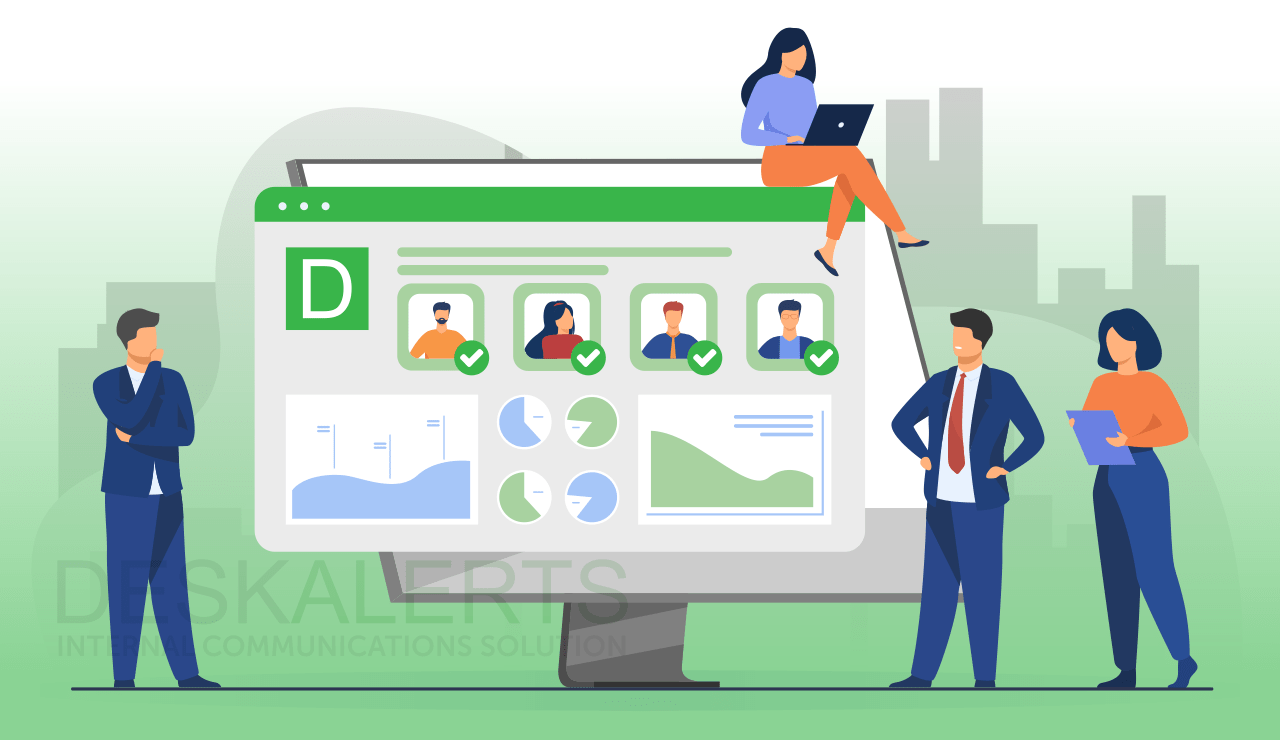
In the U.S. alone, about 85% of companies rely on cloud services (Census Bureau, 2024), and 33% of organizations worldwide have spent over $12 million annually on public cloud in 2025 (Flexera's 2025 State of the Cloud Report).
As cloud spending grows, so do the risks for business operations and IT budgets. So, to stay resilient, companies are investing in business continuity plans (BCPs).
But those plans often share one critical blind spot.
Traditional BC planning focuses heavily on data backup and infrastructure resilience while assuming employees will know how to respond when systems go down.
A study found that less than half of U.S. businesses were adequately prepared to communicate in the event of a crisis or outages (Capterra's Crisis Communications Survey, 2023).
This dangerous oversight leaves organizations vulnerable even with technically sound recovery systems in place. That’s why organizations add tools like DeskAlerts to their continuity stack. As a dedicated emergency communication solution, it fills that critical gap.
In this article, learn more about the importance of communication in BC planning, how moving to the cloud calls for clear communication protocols, and how emergency notification solutions can strengthen your cloud-based business continuity plan.
Key Takeaways
- Business continuity in the cloud must include communication protocols, not just infrastructure backups.
- Emergency notification tools are a critical (and often missing) part of a complete and truly effective business continuity communication plan.
- Crisis communication solutions are vital for operational continuity, especially during disruptions such as cloud outages, ransomware, cyberattacks, natural disasters, and more.
Table of Contents
Cloud Outage Communication Gap Examples
Pair Business Continuity Plans with Crisis Communication Solutions
5 Most Common Emergency Scenarios
How DeskAlerts Supports Your Cloud-Based Business Continuity
Don't Let a Cloud Outage Break Your Business Continuity Plan
Cloud Outage Communication Gap Examples: People Can't Respond to What They Don't Know

Even the most robust business continuity plan can become useless if your employees remain unaware, uninformed, or unable to act in an emergency.
Imagine what could happen to your business if AWS, Microsoft Azure, or Google Cloud Platform (together controlling about 63% of the global cloud infrastructure market) experiences outages:
- Frontend websites, web apps, and mobile apps (Slack, Zoom, Teams) may go offline.
- Customer-facing portals, e-commerce platforms, or SaaS products become unavailable.
- Internal tools such as CRMs, ERPs, ticketing systems, and internal dashboards may become unusable.
- Neither your employees nor your customers know what has happened and what to do.
The list can go on growing like a snowball, resulting in lost revenue, increased churn risk, breach of contract terms or SLAs with enterprise customers, and so on.
And these are not hypothetical situations. Cloud outages happen regularly. Consider, for example, these two real-world cloud-based disruptions that happened unexpectedly. They exposed this flaw and lack of solid emergency communication protocols:
- The Microsoft Outage (2025): When an accidental Azure misconfiguration disrupted businesses across multiple regions, including the United States, Europe, that relied on Microsoft's cloud infrastructure.
This massive Microsoft outage lasted for over 8 hours. During that time, employees couldn't access status updates, IT teams couldn't coordinate responses, and leadership couldn't make timely decisions – all because their communication channels were tied to the same broken system.
- The AWS US-East-1 Collapse (2021). As one of Amazon's largest cloud regions failed, it took down Slack, Zoom, and countless business applications with it. Organizations that had invested in secure business continuity found themselves paralyzed, not because their data was lost, but because they had no way to mobilize their people.
These incidents served as a reminder to other companies: diversify your communication continuity strategies and tools.
Read also: IT Outage Notification Plan + Template.
Pair Business Continuity Plans with Crisis Communication Solutions to Prepare for Disruptions
Business continuity solutions are essential as they help organizations prepare to handle disruptions, from cyberattacks to natural disasters.
But most business continuity vendors focus on documentation, workflows, and simulations. They're built to guide long-term strategy rather than responding instantly to disruptions. And during an actual emergency, teams need fast and direct communication.
Despite growing awareness, a substantial proportion (about 40%) of companies have not integrated emergency notification or crisis communication tools into their business continuity plans. This leaves them exposed to confusion and response delays during disruptions.

How This Setup Works
When you add emergency notification software (either cloud-based or on-premise) to your BC toolkit, you can send real-time hard-to-miss alerts to staff across multiple devices, be it desktops or mobile phones.
Whether it's a network outage, a cybersecurity incident, or a building evacuation, you can be sure that critical messages reach your people in seconds, even when other systems are down.
“When there are incidents and maintenance activities, we can inform our customers quickly.”– Leo Kalbermatten, Chef Operations IT, Hôpital du Valais
Below are some of the most common scenarios when crisis communication proves vital.
5 Emergency Scenarios: How a Crisis Communication Tool Helps Save Lives and Businesses
The following five real-world scenarios go beyond cloud infrastructure outages. They show why emergency notification tools like DeskAlerts are crucial for keeping your organization informed and operational during a crisis.

Scenario #1. Cloud Outage Alerting
When a major cloud service provider goes down, businesses that rely on its infrastructure can't access vital tools or data.
With an on-premise alerting system, IT teams can instantly notify all users of the issue, provide updates, and share workarounds.
Failure to communicate quickly can lead to confusion, lost productivity, and overwhelmed help desks.
“[DeskAlerts] has helped the IT department to communicate system-related information to all our users in a fast way, which has eased the workload of our helpdesk a lot during the system failures.”
– Bo B. Jørgensen, Service Desk, Topdanmark
See how an insurance company in Denmark and an American biopharmaceutical company avoided helpdesk overload and used targeted notifications to inform employees about system outages.
Scenario #2. Immediate Response to a Ransomware Attack
Ransomware attacks are currently one of the most significant business threats, with 59% of organizations affected in 2024 alone (Sophos' "State of Ransomware 2024" report).
In a ransomware attack, the longer it takes to alert staff, the greater the risk of data encryption and business disruption. Immediate alerts instructing employees to disconnect devices or avoid clicking suspicious links can contain the spread.
Having an emergency communication tool can save your business millions of dollars in damage (G2 report).
Scenario #3. Notifying About a Cyberattack in Progress
An active threat like unauthorized access or data exfiltration demands rapid internal coordination. With DeskAlerts, you can target affected departments with tailored instructions or warnings.
Relying solely on email, which may be compromised, is risky. Your team can send immediate alerts as full-screen desktop pop-ups, scrolling tickers, SMS, mobile push, or other formats to make sure employees see the messages.
This supports rapid cyberattack containment and coordinated action, which are key business continuity planning steps that protect organizations.
Read also: NHS and Cybersecurity: Raising Awareness to Protect Data.
Scenario #4. Warning About a Power Outage
Lights, machines, computers, the internet, and phones can suddenly go down during a power outage. Email servers may be down, and SMS/phone trees may not be set up. Employees could be literally left in the dark, unsure of what's happening or what to do.
Having alternative communication channels as a part of an emergency communication system helps alert your staff. Send instant messages guiding them on what to do, where to go, and how to work during outages.
CHU Saint-Pierre hospital shares how they used an emergency communication tool as an alternative way to send messages to their staff:
“When the external phone network went down, we used DeskAlerts to tell employees to switch to SMS messaging. After the bomb alerts occurred again, we used DeskAlerts to let employees know about police with sniffer dogs operating in our units.”
– Geoffrey Collet, CHU Saint-Pierre hospital
Scenario #5. Natural Disaster Alerting
From bushfires to floods, natural disasters require rapid evacuation or work-from-home transitions. Delays or miscommunication during these events can endanger lives and hinder recovery efforts.
Alerts must cut through all the digital noise and reach all staff, regardless of their location or device. DeskAlerts delivers alerts across multiple channels, including PCs, mobile, and digital signage, ensuring everyone gets the message fast.
See how a government agency used DeskAlerts to notify citizens about emergencies, including severe weather conditions – read the case study.
Now, let’s explore how DeskAlerts can support your internal communication during a crisis.
How DeskAlerts Supports Your Cloud-Based Business Continuity
DeskAlerts bridges the critical communications gap in business continuity by ensuring that your people receive urgent notifications, regardless of which systems are down.
Unlike traditional BC tools focused purely on IT recovery, DeskAlerts specializes in instant and multichannel communication, making it a valuable add-on to your existing secure business continuity strategy.
Why DeskAlerts works for business continuity communication when other systems fail:
- 100% delivery: Bypass email clutter and chat outages with pop-up alerts, SMS, mobile push notifications, desktop lock-screen notifications, and more, ensuring messages cut through the noise.
- No IT expertise needed: With an intuitive interface, any team member can quickly learn to send alerts or critical updates without delays.
- Scalable for large and enterprise-level businesses: DeskAlerts delivers real-time alerts to thousands of employees simultaneously. You can target specific people, departments, or offices with tailored messages. Also, you can set different access rights to different teams so that you have complete control over changes in the software.
- Multichannel reach: If one system fails (such as email), alerts can still be sent as SMS, mobile push messages, pop-ups, or other channels, keeping communication flowing.
- Reporting and acknowledgment tracking: See extensive reports on who received and acknowledged alerts in real time. Export it as a spreadsheet and use it in the business continuity planning process to strengthen crisis communication.
Learn more about how DeskAlerts helps organizations manage crisis communication effectively, integrates with other systems, and supports automation.
Don't Let Silence During a Cloud Outage Break Your Business Continuity Plan
Your plans for cloud infrastructure failure won't work if they overlook the emergency communication aspect – the people management aspect. And to cover this, you may need to add a dedicated on-premise crisis notification solution as a backup.
DeskAlerts is a powerful communication add-on to your business continuity toolkit, used by leading companies such as Deloitte, Fujifilm, NHS, KRKA, DHL, and more. It's the missing piece that you can use to keep people informed when email, chat, or cloud systems fail.
See how DeskAlerts would work in your existing continuity plan. Schedule a tailored walkthrough and join 60% of worldwide companies with robust emergency communication protocols.

FAQ: Communication in Business Continuity Planning
What are business continuity solutions?
Business continuity solutions are tools and strategies that help organizations prepare for disruptions, as well as respond to them and recover. They include planning software, risk assessments, recovery procedures, and communication systems. These solutions ensure that critical operations can continue during emergencies, such as cyberattacks, natural disasters, or IT failures.
What is business continuity in the cloud?
Business continuity in the cloud ensures operations continue during disruptions by leveraging redundant infrastructure, automated backups, and failover systems. Unlike traditional methods, cloud-based continuity provides scalable, on-demand recovery, but requires secure communication plans to coordinate teams when primary systems fail.
What is a business continuity communication plan?
A business continuity communication plan outlines how an organization will share critical information during a disruption. The plan includes key messages, communication channels, responsible personnel, and target audiences. It also makes sure that staff, stakeholders, and customers receive timely and accurate updates. This helps minimize confusion during emergencies or operational interruptions.
What is continuity in business communication?
Continuity in business communication ensures critical information flows during disruptions – whether from outages, cyberattacks, or disasters. It combines redundant channels (like SMS, alerts, and satellite messaging) with predefined protocols to keep teams informed and operational when email or cloud systems fail. This turns communication into a resilient lifeline, not a single point of failure.
What is the difference between business continuity and disaster recovery?
Business continuity, as a term, is used to describe a business's activities to remain operational during and after a disaster. These actions include contingency planning for how a company will operate, who will carry out specific roles, where the business will operate from, and what effects this will have on normal operations.
Disaster recovery refers to the plans a company develops to respond to a disaster or other critical event. The plan can include natural disasters, fire, data loss, cyberattacks, terrorism, and other incidents that can hamper business operations. Disaster recovery plans help to guide the organization in its response to the incident or event and provide guidance on returning to usual operations safely.
Read more: Disaster Recovery vs Business Continuity.
 Caroline Duncan
Caroline Duncan











